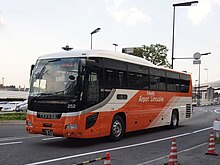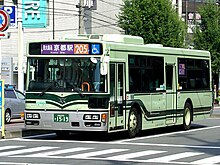Whether connecting small cities, large cities or airports, buses are an important and relatively inexpensive means of transportation in Japan.
In general
The bus most popular are those that travel on the highways of Japan at night. A few decades ago, the preferred mode of night transport was on the country's night train network. Over time, buses began to take center stage, while the night train service declined in popularity and reliability. Today, stiff competition between bus operators translates into better prices, and for those willing to pay a little more, better services.
In other parts of the country - such as Kyoto, where rail transport is scarce, or Hakone, where the winding roads have to be traveled to reach the hotels and popular hot springs - the bus becomes indispensable.
Long-distance buses (Highway buses)
The long-distance bus (高速 バ ス kōsoku basu;ハ イ ウ ェ イ バ ス haiwei basu) serve many of the intercity routes covered by trains at significantly lower prices, but they take much longer than the Shinkansen. There is a multitude of traders including Star Express is Willer Express, Kansai Bus, as well as the companies of the JR group.
Many of these are night rides (夜行 バ ス yakō basu), which allow you to save on overnight accommodation. It might be worth paying the extra to get a better seat; remember that sightseeing after a sleepless night is less fun. Look for 2 列 シ ー ト niretsu shitto or 3 列 シ ー ト sanretsu shiito, that is, there are only two or three seats per row instead of four. Intercity buses usually have significantly less legroom than intercity trains, so passengers of around 175cm can be uncomfortable.
More buses offer more luxurious Premium seating. These seats are larger, offer more legroom, and are exclusive, with only a few assigned seats in an entire bus. Examples include seats on the first floor of the service Premium Dream by JR Bus, the seats Cocoon on Willer Express services and the Dream SleeperGussuri of the Kanto Bus, which has eleven seats with sliding doors.
Some night buses can only be used by women, while some companies will do their utmost to make sure solo female travelers are not seated next to solo travelers.
For most long-distance journeys, buses will make a few stops along the way at one of Japan's service areas (abbreviated SA for short). The service areas offer vending machines, shops and of course restrooms. Note that the stops are short, so make sure you arrive in time for the bus to depart.
Tickets

Bus tickets can be purchased at the departure point, at a convenience store kiosk or on the internet, but some knowledge of Japanese may be required. Fortunately, some companies offer online bookings in a language other than Japanese. Willer Express, for example, offers online bus reservations in English, Chinese and Korean. Keio Bus offers reservations in English for their buses between Tokyo and the area of the Mount Fuji. More recently, some companies of the JR group (JR Bus Kanto, JR Tokai Bus) have started online bookings in English for their main routes.
In addition to single companies, it is also possible to search through bus portals in English such as kosokubus.com where you can also book or the site Highway bus information platform.
Competition between bus operators in recent years - especially buses between Tokyo and the Kansai - led to the adoption of dynamic pricing on many routes. This means that the price of a ticket will vary based on several factors, including:
- When the ticket is purchased: Discounts are sometimes offered for tickets purchased several days in advance.
- Travel date: a normal weekday trip will be among the lowest. The weekend trip is typically a slightly higher price and if you travel during peak periods (such as Golden Week or New Year's Eve) they will be the most expensive.
- Time of day: day trips by bus are less expensive than night trips.
- The type of seats on the bus: high-density buses designed to carry more passengers are cheaper. Buses with fewer seats per row and fewer seats on the bus in total have higher prices.
Some bus lines still operate on fixed facilities, where the fare is the same regardless of the date of travel.
Pass
There are two domestic bus passes for foreign visitors: the Japan Bus Pass and the JBL Pass.
Japan Bus Pass
Willer Express company offers the Japan Bus Pass to travel on its own motorway bus network. It is available to anyone with a foreign passport, including tourists and residents.
There are two versions: a weekday pass or the Monday-Thursday pass costs ¥ 10,000 for 3 days, ¥ 12500 for 5 days or ¥ 15000 for 7 days. A full day pass costs ¥ 12500 for 3 days or ¥ 15000 for 5 days. Travel days are not consecutive, but passes must be sold out within two months. You are limited to a maximum of three bus trips per day. Passes are non-transferable and photo identification is required for bus boarding.
If you have a lot of time on your hands and want to visit several big cities in one trip and don't mind the time spent on the buses (including overnight), the Bus Pass is worth considering. The more you travel, the cheaper the pass will be. You can potentially take Willer Express buses starting at ¥ 1000 per trip.
There are a couple of minor drawbacks to using the Bus Pass:
- Bus passes are inoperable during major Japanese holidays, such as New Year, Golden Week, and Obon. Otherwise, the Monday to Thursday pass can only be used for bus departures from Monday to Thursday, while a full day pass can be used on any day.
- It is limited to using buses that have a seating arrangement of four per row.
JBL Pass
The JBL Pass of Japan Bus Lines is similar to the Japan Bus Pass, with some differences:
- It covers a greater number of routes with companies affiliated with the Japan Bus Lines network.
- You can use the buses which have three or four seats per row.
- You can use the pass to travel on any day, except the most important holidays.
The 7-day pass costs ¥ 20,000 and the 14-day pass costs ¥ 28,000.
Airport buses

Buses are also an inexpensive way to travel to and from Japan's airports. Major cities like Tokyo and Osaka have an entire network of buses that branch off to major hotels, bus terminals and train stations, but even at smaller domestic airports you are likely to find buses operating in the city center - some will operate based on the arrival or departure of scheduled flights.
Some of the airport buses in major cities like Tokyo and Osaka are known as Limousine Buses (ス ム ジ ン バ ス rimujin basu). Some limo buses make their way to the city's dedicated terminals which are strategically placed to aim for punctual travel. Two of these terminals near Tokyo - Tokyo City Air Terminal (T-CAT) and Yokohama City Air Terminal (Y-CAT) - are right next to major highway axes.
Some companies offer discounts on regular bus prices for foreign tourists, or buy bus tickets with other extras such as a day pass for the subway. Also look for low-cost operators that simply offer cheap bus fares, such as the ¥ 1000 Access Narita bus that operates between Tokyo and Narita Airport.
Airport buses have different rules on the amount of baggage allowed in the hold per passenger (number of pieces and maximum weight), so you should check this information in advance.
Local buses

You will not need to use the local buses (ス バ ス rosen basu) in major cities, but are common in smaller cities and the payment system is worth a mention. On most buses, you are expected to board with a numbered ticket, often just a blank piece of paper automatically printed by the vending machine. At the front of the bus, near the driver, is an electronic board showing underlying numbers and prices, which inexorably advances higher as the bus moves. When it's time to disembark, you press the stop button, match your ticket number to the price of the electronic card, deposit the coupon and the corresponding payment in the car next to the driver, then go out the front door. Note that you need to pay the exact fee: to facilitate this, the machine has almost always incorporated the banknote exchange, which will hold ¥ 1,000 notes and issue ¥ 1,000 in coins per exchange. If you are short on change, it is best to swap before to descend. A useful guide to using local buses can be found here.
Increasingly, buses accept smartcards such as PASMO and Suica - you need to touch the card against a scanner at the entrance (usually above the ticket machine) and then again use the scanner next to the fare machine next to the driver when you exit. If you fail to "touch" upon entry, you will be charged the maximum fare when you step off.
The electronic board almost always includes a display and recorded voice announcements of the next stop, usually in Japanese only, although some cities (such as Kyoto) are an exception. However, if requested, most drivers will be happy to tell you when you have reached your destination.
Other projects
 Commons contains images or other files on Traveling by bus in Japan
Commons contains images or other files on Traveling by bus in Japan

